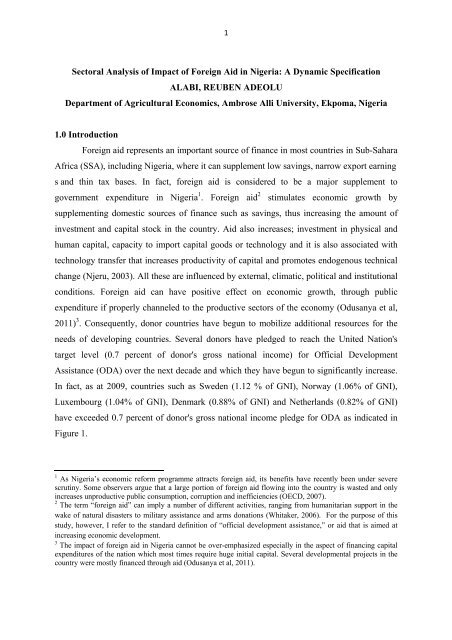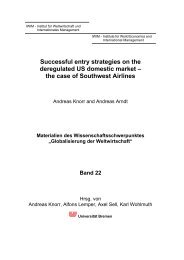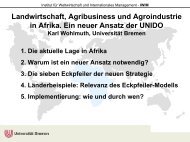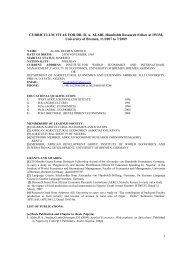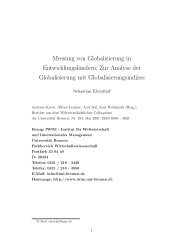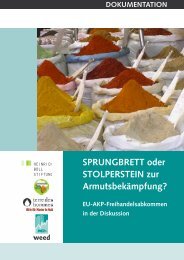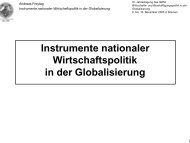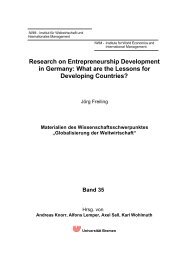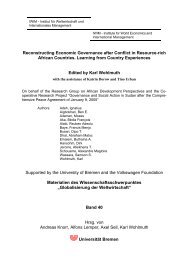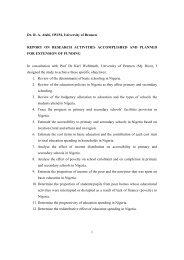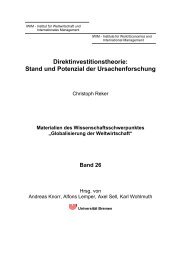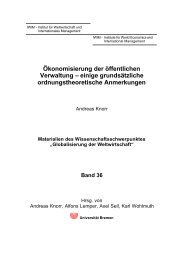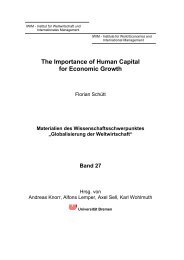Sectoral Analysis of Impact of Foreign Aid in Nigeria - Institute for ...
Sectoral Analysis of Impact of Foreign Aid in Nigeria - Institute for ...
Sectoral Analysis of Impact of Foreign Aid in Nigeria - Institute for ...
Create successful ePaper yourself
Turn your PDF publications into a flip-book with our unique Google optimized e-Paper software.
1<br />
<strong>Sectoral</strong> <strong>Analysis</strong> <strong>of</strong> <strong>Impact</strong> <strong>of</strong> <strong>Foreign</strong> <strong>Aid</strong> <strong>in</strong> <strong>Nigeria</strong>: A Dynamic Specification<br />
ALABI, REUBEN ADEOLU<br />
Department <strong>of</strong> Agricultural Economics, Ambrose Alli University, Ekpoma, <strong>Nigeria</strong><br />
1.0 Introduction<br />
<strong>Foreign</strong> aid represents an important source <strong>of</strong> f<strong>in</strong>ance <strong>in</strong> most countries <strong>in</strong> Sub-Sahara<br />
Africa (SSA), <strong>in</strong>clud<strong>in</strong>g <strong>Nigeria</strong>, where it can supplement low sav<strong>in</strong>gs, narrow export earn<strong>in</strong>g<br />
s and th<strong>in</strong> tax bases. In fact, <strong>for</strong>eign aid is considered to be a major supplement to<br />
government expenditure <strong>in</strong> <strong>Nigeria</strong> 1 . <strong>Foreign</strong> aid 2 stimulates economic growth by<br />
supplement<strong>in</strong>g domestic sources <strong>of</strong> f<strong>in</strong>ance such as sav<strong>in</strong>gs, thus <strong>in</strong>creas<strong>in</strong>g the amount <strong>of</strong><br />
<strong>in</strong>vestment and capital stock <strong>in</strong> the country. <strong>Aid</strong> also <strong>in</strong>creases; <strong>in</strong>vestment <strong>in</strong> physical and<br />
human capital, capacity to import capital goods or technology and it is also associated with<br />
technology transfer that <strong>in</strong>creases productivity <strong>of</strong> capital and promotes endogenous technical<br />
change (Njeru, 2003). All these are <strong>in</strong>fluenced by external, climatic, political and <strong>in</strong>stitutional<br />
conditions. <strong>Foreign</strong> aid can have positive effect on economic growth, through public<br />
expenditure if properly channeled to the productive sectors <strong>of</strong> the economy (Odusanya et al,<br />
2011) 3 . Consequently, donor countries have begun to mobilize additional resources <strong>for</strong> the<br />
needs <strong>of</strong> develop<strong>in</strong>g countries. Several donors have pledged to reach the United Nation's<br />
target level (0.7 percent <strong>of</strong> donor's gross national <strong>in</strong>come) <strong>for</strong> Official Development<br />
Assistance (ODA) over the next decade and which they have begun to significantly <strong>in</strong>crease.<br />
In fact, as at 2009, countries such as Sweden (1.12 % <strong>of</strong> GNI), Norway (1.06% <strong>of</strong> GNI),<br />
Luxembourg (1.04% <strong>of</strong> GNI), Denmark (0.88% <strong>of</strong> GNI) and Netherlands (0.82% <strong>of</strong> GNI)<br />
have exceeded 0.7 percent <strong>of</strong> donor's gross national <strong>in</strong>come pledge <strong>for</strong> ODA as <strong>in</strong>dicated <strong>in</strong><br />
Figure 1.<br />
1 As <strong>Nigeria</strong>’s economic re<strong>for</strong>m programme attracts <strong>for</strong>eign aid, its benefits have recently been under severe<br />
scrut<strong>in</strong>y. Some observers argue that a large portion <strong>of</strong> <strong>for</strong>eign aid flow<strong>in</strong>g <strong>in</strong>to the country is wasted and only<br />
<strong>in</strong>creases unproductive public consumption, corruption and <strong>in</strong>efficiencies (OECD, 2007).<br />
2 The term “<strong>for</strong>eign aid” can imply a number <strong>of</strong> different activities, rang<strong>in</strong>g from humanitarian support <strong>in</strong> the<br />
wake <strong>of</strong> natural disasters to military assistance and arms donations (Whitaker, 2006). For the purpose <strong>of</strong> this<br />
study, however, I refer to the standard def<strong>in</strong>ition <strong>of</strong> “<strong>of</strong>ficial development assistance,” or aid that is aimed at<br />
<strong>in</strong>creas<strong>in</strong>g economic development.<br />
3 The impact <strong>of</strong> <strong>for</strong>eign aid <strong>in</strong> <strong>Nigeria</strong> cannot be over-emphasized especially <strong>in</strong> the aspect <strong>of</strong> f<strong>in</strong>anc<strong>in</strong>g capital<br />
expenditures <strong>of</strong> the nation which most times require huge <strong>in</strong>itial capital. Several developmental projects <strong>in</strong> the<br />
country were mostly f<strong>in</strong>anced through aid (Odusanya et al, 2011).
2<br />
Source: Computed from OECD (2009)<br />
Based on new pledges and greater commitments to development assistance from<br />
donor nations, there is a possibility <strong>of</strong> significant scal<strong>in</strong>g <strong>of</strong> <strong>for</strong>eign aid resources far beyond<br />
the current and past levels (Heller, 2005). However, from the donors' perspective, the<br />
commitment to <strong>in</strong>crease aid flows to develop<strong>in</strong>g countries is only the start<strong>in</strong>g po<strong>in</strong>t. But<br />
donors have to ascerta<strong>in</strong> that aid flows are allocated among recipients and various sectors<br />
efficiently to ensure that resources will promote economic growth <strong>in</strong> recipient countries.<br />
It is there<strong>for</strong>e pert<strong>in</strong>ent to ask whether and to what extent has <strong>for</strong>eign aid might have<br />
caused or contributed to economic growth <strong>in</strong> <strong>Nigeria</strong>. And moreover, it is important to know<br />
which <strong>of</strong> the important sectors <strong>of</strong> <strong>Nigeria</strong>n economy has mostly been <strong>in</strong>fluenced by <strong>for</strong>eign<br />
aid if there is any. Accord<strong>in</strong>g to ECA (2009), it is necessary that development partners need<br />
to <strong>in</strong>crease assistance to Africa to help broaden and accelerate the recent economic growth<br />
recovery process, <strong>in</strong> order to raise the number <strong>of</strong> countries that will achieve MDGs. Kalibata<br />
(2010) is <strong>of</strong> the op<strong>in</strong>ion that <strong>for</strong>eign aid will provide the necessary solutions to Africa<br />
systemic challenges: the farmers need improved <strong>in</strong>puts, <strong>in</strong>clud<strong>in</strong>g seeds as well as improved<br />
soils; they need roads that will connect them to markets; they need agribus<strong>in</strong>ess credit and<br />
private sector <strong>in</strong>vestments to spur growth; they need facilities to reduce their estimated 40-60<br />
percent post-harvest losses and they need tra<strong>in</strong><strong>in</strong>g and technology to cope with climate<br />
change. She suggested that all these are important to African farmers to boost agricultural<br />
productivity, which can accelerate economic growth and raise <strong>in</strong>comes <strong>for</strong> communities,<br />
countries and the cont<strong>in</strong>ent as a whole. However, the subject <strong>of</strong> <strong>for</strong>eign aid rema<strong>in</strong>s a thorny<br />
issue among the donors and recipient countries. While the recipient countries want more<br />
<strong>for</strong>eign aid to push the frontier <strong>of</strong> their production possibilities, the donors want to <strong>in</strong>sist on
3<br />
the effectiveness <strong>of</strong> the aid fund to justify the need <strong>for</strong> more aid. Nevertheless, <strong>for</strong> economic<br />
justification <strong>for</strong> additional aid, there is need <strong>for</strong> empirical <strong>in</strong>vestigation on the impact <strong>of</strong> the<br />
aid on the <strong>in</strong>dividual country at the economic sector level, especially us<strong>in</strong>g dynamic<br />
estimation method 4 , tak<strong>in</strong>g <strong>in</strong>to account the stochastic and dynamic nature <strong>of</strong> the economic<br />
agents <strong>in</strong>volved <strong>in</strong> <strong>for</strong>eign aid adm<strong>in</strong>istration. This study will be relevant to the aid recipient<br />
countries <strong>in</strong> improv<strong>in</strong>g their economic growth and productivity; it will also be useful to donor<br />
countries to gauge the effectiveness <strong>of</strong> their fund <strong>in</strong> assist<strong>in</strong>g <strong>Nigeria</strong>, which is the second<br />
most important economy <strong>in</strong> Africa and largest <strong>for</strong>eign aid recipient <strong>in</strong> Africa (Odusanya et al,<br />
2011).<br />
The sectoral analysis <strong>of</strong> impact <strong>of</strong> aid <strong>in</strong> <strong>Nigeria</strong> is important because <strong>for</strong>eign aid may<br />
have differentiated impacts at the sector levels. As <strong>in</strong>dicated <strong>in</strong> Table 1, the impact <strong>of</strong> aid <strong>in</strong><br />
<strong>Nigeria</strong> that used more than 66% <strong>of</strong> ODA <strong>for</strong> debt servic<strong>in</strong>g may be different from country<br />
like Ghana that used only 7.5% <strong>for</strong> debt service and country like South Africa that has no<br />
debt to service. The impact <strong>of</strong> aid on m<strong>in</strong><strong>in</strong>g sector <strong>in</strong> <strong>Nigeria</strong> which has only about 9% <strong>of</strong> aid<br />
allocation may be lower than the impact <strong>of</strong> aid on m<strong>in</strong><strong>in</strong>g <strong>in</strong> South Africa which has more<br />
than 99% <strong>of</strong> the allocation as reveals <strong>in</strong> Table 2. This justifies country specific study <strong>of</strong><br />
impact <strong>of</strong> <strong>for</strong>eign aid <strong>in</strong>stead <strong>of</strong> common cross country studies. The sectoral allocation <strong>of</strong> aid<br />
<strong>in</strong> <strong>Nigeria</strong> <strong>in</strong>dicates that adm<strong>in</strong>istration took the lion share <strong>of</strong> the aid (26.9%) at the detriment<br />
<strong>of</strong> productive sectors such as agriculture (5.4% aid allocation), energy and m<strong>in</strong><strong>in</strong>g (9.4% aid<br />
allocation), <strong>in</strong>dustry and trade (1.9% aid allocation) and transportation (6.8% aid allocation).<br />
The sectoral imbalance <strong>in</strong> aid allocation will have differentiated results on the impact <strong>of</strong><br />
<strong>for</strong>eign aid <strong>in</strong> <strong>Nigeria</strong>n economy. This type <strong>of</strong> f<strong>in</strong>anc<strong>in</strong>g arrangement will def<strong>in</strong>itely <strong>in</strong>fluence<br />
the impact <strong>of</strong> the aid on the economy and at the sector level, with a prior expectation that<br />
sector with highest aid allocation will be most affected. It is noteworthy that the impact <strong>of</strong><br />
<strong>for</strong>eign aid at the t sectoral level has not been given consideration <strong>in</strong> analysis <strong>of</strong> impact <strong>of</strong><br />
<strong>for</strong>eign aid <strong>in</strong> <strong>Nigeria</strong> and Africa at large. There<strong>for</strong>e, this study will not only answer the<br />
question <strong>of</strong> the impact <strong>of</strong> aid <strong>in</strong> <strong>Nigeria</strong>, it will also answer the question <strong>of</strong> which <strong>of</strong> the<br />
sectors is the impact has been most significant.<br />
4 Accord<strong>in</strong>g to Durbarry et al (1998), econometric aid-growth literature has been criticized on several grounds:<br />
sample size and composition, data quality, econometric technique and specification. The dynamic specification<br />
proposed <strong>for</strong> this study will take care <strong>of</strong> weakness associated with econometric techniques employed <strong>in</strong> the past<br />
aid- growth literature.
4<br />
Table 1: Five Year Average Use <strong>of</strong> Official Development Assistance by Sector <strong>in</strong> Selected<br />
African Countries (%)<br />
Area <strong>of</strong> Uses <strong>Nigeria</strong> Ghana South Africa<br />
Debt Servic<strong>in</strong>g 66.5 7.5 -<br />
Health & Population 13.8 14.0 39.5<br />
Program Assistance 0.0 20.7 0.0<br />
Production Sector 0.0 10.3 0.0<br />
Multi-sector 0.0 6.1 7.2<br />
Education 0.0 6.3 9.9<br />
Economic<br />
6.3 19.5 11.4<br />
Infrastructure<br />
Other Social Sectors 5.5 14.6 25.7<br />
Others 7.9 1.0 6.3<br />
Source: Computed from World Bank Indicator, 2010<br />
Table 2: Five Year Average IBRD/IDA Disbursement by Sector <strong>in</strong> Selected African<br />
Countries (%) 5<br />
Sector <strong>Nigeria</strong> Ghana South Africa<br />
Public Adm<strong>in</strong>istration 26.9 36.2 0.6<br />
Health & Social Service 17.3 11.7 0.0<br />
Water & Sanitation 11.6 9.5 0.0<br />
F<strong>in</strong>ance 10.07 0.0 0.0<br />
Education 10.0 5.6 0.0<br />
Energy& M<strong>in</strong><strong>in</strong>g 9.4 17.4 99.4<br />
Transportation 6.8 7.2 0.0<br />
Agriculture 5.4 6.7 0.0<br />
Industry & Trade 1.9 0.0 0.0<br />
Others 0.0 5.8 0.0<br />
Source: Computed from World Bank Group, 2010<br />
5 This sectoral allocation may be different if total <strong>for</strong>eign aid allocations from all sources (bilateral and<br />
multilateral) are considered as revealed <strong>in</strong> appendix 1. However, the message this table is portray<strong>in</strong>g is that<br />
skewed <strong>for</strong>eign aid allocations <strong>in</strong> different country will have a different impact outcomes.
5<br />
The rest <strong>of</strong> the proposal is divided <strong>in</strong>to five sections. The <strong>in</strong>troduction above is<br />
followed by the objectives <strong>of</strong> the study <strong>in</strong> Section two; Section three justifies the importance<br />
<strong>of</strong> <strong>for</strong>eign aid and the study <strong>in</strong> the context <strong>of</strong> <strong>Nigeria</strong>. Section four reviews the literature on<br />
effectiveness <strong>of</strong> <strong>for</strong>eign aid, section five deals with econometric techniques proposed to be<br />
used to undertake the study, while section six presents the policy implications <strong>of</strong> the study.<br />
2.0 Objective <strong>of</strong> the Study<br />
The study will analyse the impact <strong>of</strong> <strong>for</strong>eign aid on different sectors <strong>of</strong> <strong>Nigeria</strong>n<br />
economy. Specifically,<br />
(i) The study will test the causality between <strong>for</strong>eign aid (bilateral and multilateral) and<br />
economic growth <strong>in</strong> <strong>Nigeria</strong>.<br />
(ii) It will determ<strong>in</strong>e the impact <strong>of</strong> <strong>for</strong>eign on critical sectors <strong>of</strong> the economy such as<br />
agriculture, manufactur<strong>in</strong>g, education and health.<br />
(iii) Make policy recommendation on sectoral <strong>for</strong>eign aid adm<strong>in</strong>istration <strong>in</strong> <strong>Nigeria</strong>.<br />
3.0 Justification <strong>for</strong> <strong>Foreign</strong> <strong>Aid</strong> and the Study<br />
Four decades after Independence <strong>in</strong> 1960, <strong>Nigeria</strong> rema<strong>in</strong>s a poor country with a per<br />
capita <strong>in</strong>come <strong>of</strong> US$260 <strong>in</strong> 2000. At the dawn <strong>of</strong> the Third Millennium, approximately 70%<br />
<strong>of</strong> the population still lived on less than US$1 a day (about 84 million people), an <strong>in</strong>dication<br />
<strong>of</strong> extreme poverty. Real GDP growth has rema<strong>in</strong>ed sluggish, averag<strong>in</strong>g 3.5% per annum<br />
s<strong>in</strong>ce 2000. It requires an annual GDP growth rate <strong>of</strong> 7-8% <strong>in</strong> order to halve the number <strong>of</strong><br />
people <strong>in</strong> poverty by 2015, and this translates to an <strong>in</strong>vestment rate <strong>of</strong> more than 30% per<br />
annum. In addition, the country faces daunt<strong>in</strong>g challenges <strong>of</strong> re-build<strong>in</strong>g a country badly<br />
damaged by decades <strong>of</strong> military misrule and a fragile democracy. There is tremendous<br />
pressure on the government to deliver some ‘democracy dividends’. Furthermore, there are<br />
the threats <strong>of</strong> preventable diseases such as malaria, HIV/AIDS, and Tuberculosis (Iyoha,<br />
2005). <strong>Nigeria</strong> is also a highly <strong>in</strong>debted country with total external debt exceed<strong>in</strong>g US$32<br />
billion <strong>in</strong> 2003 6 . The debt service burden rema<strong>in</strong>s crush<strong>in</strong>g 7 . <strong>Foreign</strong> aid <strong>in</strong> the <strong>for</strong>m <strong>of</strong><br />
6 In the 1980s, largely as a result <strong>of</strong> fall<strong>in</strong>g oil export earn<strong>in</strong>gs, <strong>Nigeria</strong>’s external debt rapidly escalated. Her<br />
external debt stock amounted to a mere US$985 million <strong>in</strong> 1977, from there <strong>Nigeria</strong> became one <strong>of</strong> the most<br />
heavily <strong>in</strong>debted countries <strong>in</strong> sub- Saharan Africa, with total external debt peak<strong>in</strong>g at over US$30.0 billion <strong>in</strong><br />
1991. In 1993, <strong>Nigeria</strong>’s per capita external debt amounted to US$300, which was roughly equal to its <strong>in</strong>come<br />
per capita. Accompany<strong>in</strong>g the escalat<strong>in</strong>g external debt has been a crush<strong>in</strong>g debt-service burden. After peak<strong>in</strong>g<br />
at 42 percent <strong>in</strong> 1986, the actual debt-service ratio (the ratio <strong>of</strong> actual debt service payments to export earn<strong>in</strong>gs)<br />
has s<strong>in</strong>ce fluctuated between 24% and 29%. A direct consequence <strong>of</strong> the escalat<strong>in</strong>g debt and high debt-service
6<br />
Official Development Assistance (ODA) has been low and decl<strong>in</strong><strong>in</strong>g dur<strong>in</strong>g the past decade.<br />
In 2002, ODA per capita was less than US$2 and total ODA was only 0 .4% <strong>of</strong> GNP. Clearly,<br />
<strong>Nigeria</strong> would f<strong>in</strong>d it difficult to atta<strong>in</strong> the Millennium Development Goals without massive<br />
assistance from Development Partners <strong>in</strong> the areas <strong>of</strong> <strong>Aid</strong>, Trade and Debt relief. The<br />
research f<strong>in</strong>d<strong>in</strong>gs <strong>in</strong>dicate that the development problems confront<strong>in</strong>g <strong>Nigeria</strong> are so huge and<br />
overwhelm<strong>in</strong>g that <strong>Nigeria</strong>ns alone would not overcome them. It takes both national and<br />
<strong>in</strong>ternational cooperation to br<strong>in</strong>g them to an end (AFRODAD, 2005).<br />
However, <strong>for</strong> <strong>Nigeria</strong> to benefit more from <strong>for</strong>eign assistance <strong>in</strong> the <strong>for</strong>m <strong>of</strong> aid, the<br />
donors must be conv<strong>in</strong>ced <strong>of</strong> her effectiveness <strong>in</strong> management <strong>of</strong> the aid. This is important<br />
because much <strong>of</strong> the ODA <strong>in</strong>flows <strong>in</strong> <strong>Nigeria</strong> by-pass national budgets (Iyoha, 2003). In<br />
<strong>Nigeria</strong>, the aid fund goes directly to the m<strong>in</strong>istries, department or agency (MDA) that uses<br />
the fund. This is contrary to what happened <strong>in</strong> other Sub Sahara African Countries such as<br />
Kenya and Ghana <strong>in</strong> which <strong>for</strong>eign aid is treated as part <strong>of</strong> the budget. The Senate (<strong>in</strong><br />
<strong>Nigeria</strong>) has warned aga<strong>in</strong>st the disbursement <strong>of</strong> <strong>for</strong>eign aid com<strong>in</strong>g <strong>in</strong>to the country without<br />
National Assembly's <strong>in</strong>volvement. The lawmakers are now <strong>in</strong>sist<strong>in</strong>g that such funds must<br />
hence<strong>for</strong>th be captured <strong>in</strong> the nation’s budget process <strong>for</strong> the purpose <strong>of</strong> track<strong>in</strong>g its flow and<br />
disbursement <strong>in</strong>to <strong>Nigeria</strong>’s critical sectors (The Will, 2011). The idea is that by-pass<strong>in</strong>g<br />
budget will result <strong>in</strong> timely release <strong>of</strong> the aid to the critical sectors <strong>of</strong> the economy. This is<br />
envisaged to make aid effective (untimely release <strong>of</strong> <strong>for</strong>eign aid fund due to budget delay <strong>in</strong><br />
develop<strong>in</strong>g countries can lead to the poor per<strong>for</strong>mance <strong>of</strong> the projects <strong>in</strong> which aid fund is<br />
designed <strong>for</strong> (Njeru, 2003). Another reason <strong>for</strong> by-pass<strong>in</strong>g the budget is the fact that they<br />
want to ensure that aid money is not diverted to non-aided projects <strong>in</strong> the country. There<strong>for</strong>e,<br />
empirical evidence <strong>of</strong> impact <strong>of</strong> <strong>for</strong>eign aid <strong>in</strong> different sectors <strong>of</strong> economy <strong>in</strong> <strong>Nigeria</strong> that<br />
adopt different aid management(utilization) system will be <strong>of</strong> <strong>in</strong>terest to donors and other aid<br />
recipient countries <strong>in</strong> Africa.<br />
burden is that there is <strong>in</strong>sufficient <strong>for</strong>eign exchange to f<strong>in</strong>ance the importation <strong>of</strong> raw materials, <strong>in</strong>termediate<br />
goods, and capital goods needed <strong>for</strong> rapid economic development. <strong>Nigeria</strong>’s domestic debt has also been ris<strong>in</strong>g,<br />
fuelled primarily by escalat<strong>in</strong>g fiscal deficits. By the end <strong>of</strong> 2004, it owed Paris Club $31 billion (out <strong>of</strong> a total<br />
debt <strong>of</strong> $36 billion) despite hav<strong>in</strong>g had almost no new loans. That is, <strong>Nigeria</strong>’s debt to the Paris Club ballooned<br />
by around $23 billion dollars because <strong>of</strong> arrears, f<strong>in</strong>es and compound <strong>in</strong>terest. <strong>Nigeria</strong>’s people did not see any<br />
<strong>of</strong> this money, but have been repay<strong>in</strong>g it anyway.<br />
7 The potential benefit <strong>of</strong> debt relief to low-<strong>in</strong>come countries has been highlighted by Bhattacharya and<br />
Clements, 2004).
7<br />
Moreover, World Bank (2005) reports that Iraq was the top recipient <strong>of</strong> development<br />
aid <strong>in</strong> 2005 followed by <strong>Nigeria</strong> 8 . However, this is due to the significant debt relief deals that<br />
were granted to these nations that year - when donor countries write <strong>of</strong>f a portion <strong>of</strong> a<br />
recipient country's debt, it is counted as ODA from the donor country. This expla<strong>in</strong>s high<br />
proportion <strong>of</strong> aid that went to <strong>Nigeria</strong> <strong>in</strong> 2005; <strong>Nigeria</strong> was granted debt cancellation <strong>of</strong> about<br />
19 billion US Dollars. This <strong>for</strong>m <strong>of</strong> aid is expected to have developmental impacts <strong>in</strong> <strong>Nigeria</strong><br />
as the money saved through the debt <strong>for</strong>giveness was channeled <strong>in</strong>to meet<strong>in</strong>g MDGs <strong>in</strong><br />
<strong>Nigeria</strong> (Alabi and Adam, 2011) 9 . So this fund is expected to have a higher impact on MDG<br />
focused sectors such as education, health and agriculture than other non-MDG focused<br />
sectors. Whether MDG focused sectors were more impacted by <strong>for</strong>eign aid or not needs be<br />
supported by evidence that will warrant a study <strong>of</strong> this nature. In addition, Njeru (2003) noted<br />
that it may be <strong>in</strong>terest<strong>in</strong>g to assess whether a dist<strong>in</strong>ction between bilateral and multilateral aid<br />
<strong>in</strong>fluences sectors <strong>of</strong> the economy differently, a feat which has not been attempted <strong>in</strong> Sub<br />
Sahara Africa. This study <strong>in</strong>tends to fill that vacuum.<br />
F<strong>in</strong>ally, Odusanya et al (2011) vividly revealed that <strong>for</strong>eign aid and government<br />
expenditure have contributed to economic growth <strong>in</strong> <strong>Nigeria</strong>, but that the impact has not been<br />
qualitative on the welfare <strong>of</strong> the <strong>Nigeria</strong>n populace. Consequently, they recommended that<br />
<strong>for</strong>eign aid and government expenditure should be judiciously utilized <strong>in</strong> provid<strong>in</strong>g necessary<br />
socio-economic <strong>in</strong>frastructure (adequate power, roads etc), required to stimulate economic<br />
growth and development at a satisfactory pace <strong>in</strong> <strong>Nigeria</strong>. However, this conclusion can be<br />
misplaced because they did not exam<strong>in</strong>e the impact <strong>of</strong> <strong>for</strong>eign aid on those sectors (powers,<br />
road, etc). For an objective conclusion to be drawn on which <strong>of</strong> the sectors to emphasize <strong>in</strong><br />
8 As a result <strong>of</strong> the oil boom, <strong>Nigeria</strong>’s per capita <strong>in</strong>come <strong>in</strong>creased sharply from US$250 <strong>in</strong> 1973 to US$1,000<br />
<strong>in</strong> 1980. This caused <strong>Nigeria</strong> to be classified as a middle-<strong>in</strong>come country and ODA assistance naturally<br />
decl<strong>in</strong>ed. The end <strong>of</strong> the oil boom and the economic crisis <strong>of</strong> the mid - 1980s led to a drastic fall <strong>in</strong> the per capita<br />
<strong>in</strong>come; <strong>Nigeria</strong> was then re-classified as a low-<strong>in</strong>come country <strong>in</strong> the year 1989. ODA flows have been<br />
<strong>in</strong>creas<strong>in</strong>g s<strong>in</strong>ce then (AFRODAD, 2005). For <strong>in</strong>stance, there was gradual reduction <strong>in</strong> the amount <strong>Nigeria</strong><br />
received as aid between 1970 and 1979 (from $590.47million to $28.92million), and it later rose to<br />
$473.63million <strong>in</strong> 1989. By 2005, <strong>Nigeria</strong> experienced a sharp <strong>in</strong>crease <strong>in</strong> the amount she received as aid. The<br />
value rose from $360.78million <strong>in</strong> 2004 to $6799.81 million <strong>in</strong> 2005. The follow<strong>in</strong>g year (2006) also witnessed<br />
almost the double amount <strong>of</strong> the amount she received <strong>in</strong> 2005; it rose to $11781.51million but later fell to<br />
$1385.2million <strong>in</strong> 2007. Appendix 3 <strong>in</strong>dicates that they were about $1401 million and $1638 million <strong>in</strong> 2008<br />
and 2009 at constant 2009 US dollars.<br />
9 After the US$19 billion debt owed by <strong>Nigeria</strong> to the Paris Club was successfully written <strong>of</strong>f by the creditors,<br />
the deal was to direct the sav<strong>in</strong>gs that the country would make from not hav<strong>in</strong>g to pay <strong>for</strong> the debts to pro-poor<br />
projects and programmes which would, <strong>in</strong> turn, assist <strong>in</strong> atta<strong>in</strong><strong>in</strong>g the Millennium Development Goals (Okeke,<br />
2009)
8<br />
spend<strong>in</strong>g <strong>for</strong>eign aid , there is need to exam<strong>in</strong>e the sectoral impact <strong>of</strong> aid on the core sectors<br />
that are <strong>of</strong> much importance to the poor, such as education, health, agriculture, etc.<br />
4.0 Effectiveness <strong>of</strong> <strong>Foreign</strong> <strong>Aid</strong> on the Economy<br />
There are two contrast<strong>in</strong>g sides to the debate on the effectiveness <strong>of</strong> <strong>for</strong>eign aid on<br />
economic growth. One argues that aid has a positive effect on economic growth, with even<br />
more impact <strong>in</strong> countries with sound economic and trade policies. The other contends that<br />
<strong>for</strong>eign aid causes corruption, encourages rent-seek<strong>in</strong>g behavior, and erodes bureaucratic<br />
<strong>in</strong>stitutions (Whitaker, 2006). A renewed <strong>in</strong>terest <strong>in</strong> expla<strong>in</strong><strong>in</strong>g cross-country economic<br />
growth emerged <strong>in</strong> the early 1990s, with numerous studies attempt<strong>in</strong>g to answer the <strong>for</strong>eign<br />
aid question. To date, however, there is no consensus among scholars as to the actual effects<br />
<strong>of</strong> <strong>for</strong>eign aid on economic growth. There have been several prom<strong>in</strong>ent studies which f<strong>in</strong>d a<br />
causal l<strong>in</strong>k between <strong>for</strong>eign aid and economic growth, such as Burnside and Dollar (2004).<br />
They found that <strong>for</strong>eign aid enhances economic growth, so long as “good” fiscal policies are<br />
<strong>in</strong> place. These policies can <strong>in</strong>clude ma<strong>in</strong>ta<strong>in</strong><strong>in</strong>g small budget deficits, controll<strong>in</strong>g <strong>in</strong>flation,<br />
and be<strong>in</strong>g open to global trade. Durbarry, et al. (1998) also found a positive association<br />
between <strong>for</strong>eign aid and economic growth, and supported Burnside and Dollar’s f<strong>in</strong>d<strong>in</strong>g <strong>of</strong><br />
conditionality on good economic policy. The study also concluded, however, that the degree<br />
to which aid impacts GDP depends largely on other factors as well, such as geography. Ali<br />
and Isse (2005) further confirmed the f<strong>in</strong>d<strong>in</strong>gs <strong>of</strong> Burnside and Dollar. The study also<br />
demonstrated that aid is subject to decreas<strong>in</strong>g marg<strong>in</strong>al returns, <strong>in</strong>dicat<strong>in</strong>g a threshold beyond<br />
which development assistance can become detrimental to economic growth.<br />
Whitaker (2006) <strong>in</strong>dicates that massive expenditures on <strong>for</strong>eign aid programs by<br />
developed nations and <strong>in</strong>ternational <strong>in</strong>stitutions, <strong>in</strong> comb<strong>in</strong>ation with the perceived lack <strong>of</strong><br />
results from these disbursements, raise important questions as to the actual effectiveness <strong>of</strong><br />
monetary assistance to less developed countries (LDCs). In his analysis, he focused on 119<br />
low- and medium-development countries, and measured the impact that <strong>for</strong>eign aid has on<br />
their growth rates <strong>of</strong> gross domestic product, us<strong>in</strong>g dummy variables <strong>for</strong> geography and<br />
conflict <strong>in</strong> a geometric lag model. The results <strong>in</strong>dicate that <strong>for</strong>eign aid donations do have a<br />
positive impact on the economic growth <strong>of</strong> the recipient nation. The effect is extremely<br />
modest, however, and other factors such as armed conflict and geography can easily mitigate<br />
this impact, <strong>in</strong> some cases to the extent that <strong>for</strong>eign aid becomes detrimental to economic<br />
growth.
9<br />
Not all research has shown that a positive relationship to exist between aid and<br />
growth. Even be<strong>for</strong>e Burnside and Dollar’s monumental f<strong>in</strong>d<strong>in</strong>gs, a study by Boone (1995)<br />
found that aid-<strong>in</strong>tensive African countries experienced zero per capita economic growth <strong>in</strong><br />
the 1970s and 80s, despite <strong>for</strong>eign aid actually <strong>in</strong>creas<strong>in</strong>g (as measured by share <strong>of</strong> GDP) 10 .<br />
Additionally, Knack (2001) found that high levels <strong>of</strong> <strong>for</strong>eign aid can erode bureaucratic and<br />
<strong>in</strong>stitutional quality, trigger<strong>in</strong>g corruption, and encourag<strong>in</strong>g rent-seek<strong>in</strong>g behavior. The most<br />
ardent critics <strong>of</strong> aid programs, especially Bauer (1971) and Friedman (1958), attack <strong>for</strong>eign<br />
assistance on the grounds that politicians will not allocate aid efficiently when measured<br />
aga<strong>in</strong>st the goals <strong>of</strong> aid programs. They argue that recipient countries will consume capital<br />
<strong>in</strong>flows s<strong>in</strong>ce lack <strong>of</strong> domestic sav<strong>in</strong>gs reflects lack <strong>of</strong> opportunities. There is also evidence<br />
that the effects <strong>of</strong> <strong>for</strong>eign aid can be mitigated by other non-economic factors. Situations <strong>of</strong><br />
state failure, such as ethnic conflict, genocide, and revolution can all potentially <strong>in</strong>fluence the<br />
extent to which aid impacts growth.<br />
Accord<strong>in</strong>g to Djankov, et al (2005), <strong>for</strong>eign aid provides a w<strong>in</strong>dfall <strong>of</strong> resources to<br />
recipient countries and may result <strong>in</strong> the same rent seek<strong>in</strong>g behavior as documented <strong>in</strong> the<br />
“curse <strong>of</strong> natural resources” literature. In their paper, they discussed this effect and document<br />
its magnitude. Us<strong>in</strong>g data <strong>for</strong> 108 recipient countries <strong>in</strong> the period 1960 to 1999, they found<br />
that <strong>for</strong>eign aid has a negative impact on democracy. For comparison, they also measure the<br />
effect <strong>of</strong> oil rents on political <strong>in</strong>stitutions. They concluded that <strong>for</strong>eign aid is a bigger curse<br />
than oil.<br />
The need <strong>for</strong> specific country case study is imperative because many <strong>of</strong> the literature<br />
on the <strong>for</strong>eign aid and its impact on development <strong>in</strong> the recipient countries focus on the<br />
relationship between aid and economic growth and uses <strong>in</strong>ternational cross section statistical<br />
<strong>in</strong>vestigations rather than <strong>in</strong>dividual country case study (Riddell, 1987; Mosley et al, 1987).<br />
The results <strong>of</strong> the cross-section studies usually depend on the countries and periods <strong>of</strong> study<br />
chosen. Such studies face numerous problems <strong>of</strong> measurement and <strong>in</strong>terpretation and <strong>of</strong>ten<br />
ignore the stylized structural features <strong>of</strong> <strong>in</strong>dividual countries. For example, <strong>for</strong>eign aid was<br />
once associated with reduced domestic sav<strong>in</strong>gs, but comprehensive surveys on <strong>in</strong>dividual<br />
recipient countries have proved otherwise. <strong>Foreign</strong> aid can <strong>in</strong>fluence, either positively or<br />
negatively, the expenditure patterns and economic development <strong>of</strong> the recipient countries.<br />
10 Boone (1995) concluded that aid does not significantly <strong>in</strong>crease <strong>in</strong>vestment and growth, nor benefit the poor<br />
but it does <strong>in</strong>crease the size <strong>of</strong> government. He also found that the impact <strong>of</strong> aid does not vary accord<strong>in</strong>g to<br />
whether recipient governments are liberal democratic or highly repressive.
10<br />
Fiscal analysts and the donor communities are conv<strong>in</strong>ced that the aid process is underm<strong>in</strong>ed<br />
by the ability <strong>of</strong> the recipient governments to alter their spend<strong>in</strong>g patterns to subvert the<br />
sectoral distribution <strong>of</strong> expenditure <strong>for</strong> designated projects. Empirical literature <strong>of</strong> the impact<br />
on <strong>for</strong>eign aid and government expenditure is also <strong>in</strong>conclusive. A few studies (Heller, 1975;<br />
Khilji and Zampelli, 1991; Pack and Pack, 1993) have supported the theoretical proposition<br />
that develop<strong>in</strong>g countries have been render<strong>in</strong>g <strong>for</strong>eign aid fungible by transferr<strong>in</strong>g resources<br />
from the donor-aid sectors to non-donor aided sectors. Accord<strong>in</strong>g to the World Bank's 1998<br />
report, assess<strong>in</strong>g aid, countries with good monetary, fiscal and trade policies ( i.e. good policy<br />
environment) registered high positive effect <strong>of</strong> aid. Such good policy environment depends<br />
on the donor or recipient country. These reasons underlie the impact <strong>of</strong> aid on the recipient<br />
expenditure pattern. However, <strong>of</strong> great importance is whether recipient countries spend donor<br />
funds on <strong>in</strong>tended purposes. Studies us<strong>in</strong>g time series data <strong>in</strong> <strong>in</strong>dividual countries (Levy,<br />
1987; McGuire, 1978, 1987; Gang and Khan, 1990; Pack and Pack, 1990) found no<br />
significant diversion and all agree that countries spend <strong>for</strong>eign aid funds on the designated<br />
purposes. These reasons <strong>in</strong>fluence the impact <strong>of</strong> aid on the recipient expenditure pattern.<br />
At sectoral level, Feyzioglu et al, (1998) found that aid is fungible on earmarked<br />
concessional loans <strong>for</strong> agriculture, education and energy, but not <strong>for</strong> transport and<br />
communication sectors. Pack and Pack (1990, 1993) concur with Feyzioglu, et al (<strong>in</strong> the case<br />
<strong>of</strong> Indonesia and Sri Lanka) that strong fly paper effect does occur on concessional loans (but<br />
the results differ with data on the Dom<strong>in</strong>ican Republic). The evidence that aid money<br />
<strong>in</strong>creases government expenditure means that the recipient governments do use the <strong>in</strong>creased<br />
resources as they choose to <strong>in</strong>crease spend<strong>in</strong>g, cut taxes or reduce fiscal deficits.<br />
Further on the effect <strong>of</strong> <strong>for</strong>eign aid on government expenditure, Devarajan, et al<br />
(1998) found that most aid (about 90%) boosted government expenditure with no significant<br />
evidence <strong>of</strong> tax relief. About half the aid was used to f<strong>in</strong>ance external debt service payments;<br />
one quarter to f<strong>in</strong>ance <strong>in</strong>vestments and the other quarter to <strong>of</strong>fset current account deficits. On<br />
the other hand, Swaroop et al (2000), focus<strong>in</strong>g on the effects <strong>of</strong> <strong>for</strong>eign aid on expenditure<br />
decisions <strong>of</strong> central government <strong>of</strong> India, found that <strong>for</strong>eign aid merely substitute <strong>for</strong> already<br />
earmarked government spend<strong>in</strong>g; the central government spends funds obta<strong>in</strong>ed through aid<br />
on non-development activities. This means that government choices are unaffected by<br />
external sources <strong>of</strong> f<strong>in</strong>ance. F<strong>in</strong>ally, empirical literature us<strong>in</strong>g both panel and time series data<br />
supports the notion that aid <strong>in</strong>creases government expenditure. The ma<strong>in</strong> question is, if an aid<br />
<strong>in</strong>crease leads to <strong>in</strong>creased government spend<strong>in</strong>g, what happens dur<strong>in</strong>g the periods <strong>of</strong>
11<br />
decl<strong>in</strong>es <strong>in</strong> the flow <strong>of</strong> aid? Studies by Corden (1984), Killick (1991) and Nyoni (1997) have<br />
confirmed that huge receipts <strong>of</strong> <strong>for</strong>eign aid by develop<strong>in</strong>g countries do have effects on growth<br />
similar to those <strong>of</strong> the discovery <strong>of</strong> natural resources. On the other hand, Bevan et al (1993)<br />
noted that the effects <strong>of</strong> <strong>in</strong>creased f<strong>in</strong>ancial resources depend on the type <strong>of</strong> expenditure the<br />
boom (aid) f<strong>in</strong>ances.<br />
5.0 Methodology<br />
This study will cover a period <strong>of</strong> thirty years rang<strong>in</strong>g from 1981 to 2010. The data <strong>for</strong><br />
the study will be sourced from the Central Bank <strong>of</strong> <strong>Nigeria</strong> (CBN), National Bureau <strong>of</strong><br />
Statistics (NBS) and the Organization <strong>for</strong> Economic Cooperation and Development (OECD)<br />
websites. The data on GDP <strong>for</strong> each <strong>of</strong> the sector <strong>of</strong> the economy on time series are readily<br />
available <strong>in</strong> the CBN publications and website. Data on health and education outcomes on<br />
yearly basis can be accessed from NBS publications and website. As <strong>for</strong> ODA data, they are<br />
available as OECD Stat at the OECD website. They are available on the aggregate and<br />
disaggregate <strong>for</strong>ms. For example there is ODA allocation to <strong>Nigeria</strong>, to sectors (as presented<br />
<strong>in</strong> appendix 1), such as education and to different levels <strong>of</strong> education, that is basic, secondary<br />
and post secondary (as <strong>in</strong>dicated <strong>in</strong> appendix 2).<br />
Various econometric tools will be employed <strong>in</strong> this study, such as Vecto-Autoregression<br />
(VAR), Granger causality test and Variance Decomposition. In the analysis <strong>of</strong> the<br />
data, the study will rely on the framework <strong>of</strong> Durbarry, et al (1998) 11 as modified by<br />
Odusanya et al (2011) 12 <strong>in</strong> the case <strong>of</strong> <strong>Nigeria</strong>. Odusanya et al (2011) hypothesized that<br />
economy growth <strong>in</strong> <strong>Nigeria</strong> can be related to <strong>for</strong>eign aid as stated <strong>in</strong> equation 1.<br />
Growth = ß 0 +ß 1 FAID + ß 2 PRIV + ß 3 SAV + ß 4 TRADE + ß 5 GOV + e . . . (1)<br />
Where, Growth is the Average GDP growth, FAID is the Official Development Assistance<br />
(ODA) as def<strong>in</strong>ed by the Organisation <strong>for</strong> Economic Cooperation and Development<br />
11 Durbarry, et al (1998) exam<strong>in</strong>ed aid’s growth impact with<strong>in</strong> augmentations <strong>of</strong> two prom<strong>in</strong>ent endogenous<br />
growth models: the ‘Fischer-Easterly model’ and the so-called ‘Barro model’. The <strong>for</strong>mer <strong>in</strong> particular - which<br />
stresses the role <strong>of</strong> stable macroeconomic policies <strong>for</strong> susta<strong>in</strong>ed growth - has found <strong>in</strong>creas<strong>in</strong>g empirical support<br />
<strong>in</strong> the recent literature. With its emphasis on the role <strong>of</strong> economic policy, the Fischer-Easterly model provides a<br />
natural context with<strong>in</strong> which to study the aid-growth relationship, s<strong>in</strong>ce many have argued that the<br />
developmental impact <strong>of</strong> aid is conditioned by the policy environment <strong>in</strong> recipient countries. So Durbarry, et al<br />
(1998) exam<strong>in</strong>ed the growth impact <strong>of</strong> aid with<strong>in</strong> a model that <strong>in</strong>cluded both policy variables and all the major<br />
sources <strong>of</strong> <strong>in</strong>vestment f<strong>in</strong>ance – <strong>for</strong>eign aid, private and other <strong>in</strong>flows, and domestic sav<strong>in</strong>gs.<br />
12 However, Durbarry, et al (1998) and Odusanya et al (2011) carried out their studies us<strong>in</strong>g static framework.<br />
Their conclusions may be <strong>in</strong>correct because the economic agents associated with aid adm<strong>in</strong>istration are<br />
dynamic. The dynamic model I <strong>in</strong>tend to use will be able to capture the dynamic nature <strong>of</strong> these agencies. It<br />
should be noted that Durbarry, et al (1998) and Odusanya et al (2011) did not disaggregate the GDP <strong>in</strong>to<br />
different sector levels.
12<br />
(OECD) 13 . The full list <strong>of</strong> sources <strong>of</strong> ODA to <strong>Nigeria</strong> and the world is presented <strong>in</strong><br />
appendices 3 and 4 respectively. PRIV is the Total net private capital flows as a percentage <strong>of</strong><br />
GDP(<strong>in</strong>ternational remittance can also be classified as part <strong>of</strong> net private capital flows), SAV<br />
is the Domestic sav<strong>in</strong>gs as a percentage <strong>of</strong> GDP, TRADE 14 is the Openness to trade, which is<br />
def<strong>in</strong>ed as (X + M) /GDP 15 . GOV represents the total amount <strong>of</strong> government expenditure as a<br />
percentage <strong>of</strong> GDP.<br />
However, <strong>in</strong> order to concentrate on the dynamic effect <strong>of</strong> <strong>for</strong>eign aid on the<br />
economic growth at the sectoral levels, the equation 1 is first modified to Vector Autoregression<br />
model (VAR) as:<br />
p<br />
FA t = β 0 + ∑ β<br />
1 jFAi<br />
+<br />
t−<br />
j ∑β<br />
j=<br />
1<br />
p<br />
j=<br />
1<br />
2<br />
AG<br />
j i t−<br />
j<br />
+ l<br />
it<br />
. . . (2)<br />
p<br />
AG t = a 0 + ∑a1 jAG it−<br />
j<br />
+ ∑a2 jFA i<br />
+ µ<br />
t−<br />
j it<br />
. . .<br />
j=<br />
1<br />
p<br />
j=<br />
1<br />
(3)<br />
Where FA and AG are Official Development Assistance (ODA) as def<strong>in</strong>ed by the<br />
Organisation <strong>for</strong> Economic Cooperation and Development (OECD) and average GDP growth<br />
respectively, while FA t-j and AG t-j represent their lagged values <strong>in</strong> j years, p is the maximum<br />
lag length 16 , and l and µ are error terms and, β s and a s are parameters to be estimated.<br />
Given that ord<strong>in</strong>ary least squares (OLS) and generalized least squares (GLS) will yield biased<br />
estimates <strong>in</strong> the presence <strong>of</strong> correlations between the lagged FA and AG variables, I will<br />
employ a generalized method <strong>of</strong> moments (GMM) estimator to obta<strong>in</strong> consistent parameter<br />
estimates (Holtz-Eak<strong>in</strong> et al., 1988). Differenc<strong>in</strong>g away the fixed effects and <strong>in</strong>clud<strong>in</strong>g<br />
TRADE , GOV and D ( D is dummy variable that is <strong>in</strong>cluded to capture the two ma<strong>in</strong> policy<br />
era <strong>in</strong> <strong>Nigeria</strong>. D= 1 dur<strong>in</strong>g SAP and 0 otherwise), equation 2 and 3 will be trans<strong>for</strong>med to<br />
13 ODA is the flows <strong>of</strong> <strong>of</strong>ficial f<strong>in</strong>anc<strong>in</strong>g adm<strong>in</strong>istered with the promotion <strong>of</strong> the economic development and<br />
welfare <strong>of</strong> develop<strong>in</strong>g countries as the ma<strong>in</strong> objective, and which are concessional <strong>in</strong> character with a grant<br />
element <strong>of</strong> at least 25 percent (us<strong>in</strong>g a fixed 10 percent rate <strong>of</strong> discount). By convention, ODA flows comprise<br />
contributions <strong>of</strong> donor government agencies, at all levels, to develop<strong>in</strong>g countries (“bilateral ODA”) and to<br />
multilateral <strong>in</strong>stitutions. ODA receipts comprise disbursements by bilateral donors and multilateral <strong>in</strong>stitutions.<br />
In other words, ODA needs to conta<strong>in</strong> the three elements: (a) undertaken by the <strong>of</strong>ficial sector; (b) with<br />
promotion <strong>of</strong> economic development and welfare as the ma<strong>in</strong> objective; and (c) at concessional f<strong>in</strong>ancial terms<br />
(if a loan, hav<strong>in</strong>g a grant element <strong>of</strong> at least 25 per cent).<br />
14 PRIV, SAV TRADE and GOV are <strong>in</strong>cluded <strong>in</strong> the model to capture potential side effects <strong>of</strong> <strong>for</strong>eign aid (such<br />
as ‘Dutch-Disease’effects) and other policy variables that are hypothesised to affect growth. Although<br />
Burnside and Dollar (1997), found that though the ratio <strong>of</strong> aid to GDP <strong>of</strong>ten does not significantly affect growth<br />
<strong>in</strong> LDCs, but aid <strong>in</strong>teracted with policy variables does.<br />
15 That is the addition <strong>of</strong> export and import divided by Gross Domestic Product.<br />
16 The Lag Exclusion Wald Tests will be used to select the most appropriate lag length.
13<br />
equations 4 and 5 respectively. These equations will be estimated to exam<strong>in</strong>e the impact <strong>of</strong><br />
<strong>for</strong>eign on the <strong>Nigeria</strong>n economy at the aggregate level.<br />
In the sectoral analysis, the impact <strong>of</strong> <strong>for</strong>eign aid on agriculture, manufactur<strong>in</strong>g,<br />
health and education, will be analysed. Go<strong>in</strong>g by equations 4 and 5, FA will be the Official<br />
Development Assistance <strong>for</strong> agriculture, <strong>in</strong>dustry, health and education respectively, while<br />
AG will be the agriculture GDP average growth rate, manufactur<strong>in</strong>g average growth rate,<br />
average growth rate <strong>of</strong> health facilities and average growth rate <strong>of</strong> school enrolment<br />
respectively <strong>for</strong> the period under consideration <strong>in</strong> the sectoral analysis.<br />
In the disaggregation analysis <strong>of</strong> <strong>for</strong>eign aid, FA <strong>in</strong> equations 4 and 5 will be<br />
disaggregated <strong>in</strong>to bilateral and multilateral <strong>for</strong>eign aid respectively and the analysis proceeds<br />
as proposed under sectoral analysis. For example, we can exam<strong>in</strong>e the effect <strong>of</strong> bilateral<br />
<strong>for</strong>eign aid on economic growth <strong>in</strong> <strong>Nigeria</strong> by represent<strong>in</strong>g FA <strong>in</strong> equations 4 and 5 as<br />
bilateral <strong>for</strong>eign aid, while every other variable is reta<strong>in</strong>ed <strong>in</strong> the equation. The same th<strong>in</strong>g<br />
can be done <strong>in</strong> the case <strong>of</strong> multilateral <strong>for</strong>eign aid. FA <strong>in</strong> equations 4 and 5 will represent<br />
multilateral <strong>for</strong>eign aid, while every other variable is reta<strong>in</strong>ed <strong>in</strong> the equation.<br />
p<br />
∆FA t = β 0 + ∑ β<br />
1 j∆FAi<br />
+<br />
t−<br />
j ∑β 2<br />
∆AG j i t−<br />
j<br />
+ δ<br />
jDi<br />
+<br />
+<br />
t−<br />
j ∑δ jGOVi<br />
+<br />
t−<br />
j ∑γ<br />
jTRADEi<br />
t−<br />
j<br />
j=<br />
1<br />
p<br />
p<br />
j=<br />
1<br />
2<br />
∑<br />
j=<br />
1<br />
η i . . . (4)<br />
∆AG t = a 0 + ∑a1 j∆AG i t−<br />
j<br />
+ a2 j∆FA it−<br />
j<br />
+ δ<br />
jDi<br />
+ δ +<br />
t−<br />
j<br />
jGOVi<br />
γ<br />
+<br />
t−<br />
j<br />
jTRADEit−<br />
j<br />
j=<br />
1<br />
p<br />
∑<br />
j=<br />
1<br />
2<br />
∑<br />
j=<br />
1<br />
ζ i . . . (5)<br />
The Granger Causality test<br />
I will also per<strong>for</strong>m the Granger causality test between the <strong>for</strong>eign and economic<br />
growth and at the sectoral level, to determ<strong>in</strong>e whether <strong>for</strong>eign aid causes economic growth<br />
both at the aggregate and the sectoral level. The Granger causality test is a statistical hypothes<br />
is test <strong>for</strong> determ<strong>in</strong><strong>in</strong>g whether one time series is useful <strong>in</strong> <strong>for</strong>ecast<strong>in</strong>g another (Granger, 1969<br />
). Test<strong>in</strong>g causality, <strong>in</strong> the Granger sense, <strong>in</strong>volves us<strong>in</strong>g F-test to test whether lagged<br />
<strong>in</strong><strong>for</strong>mation on <strong>for</strong>eign aid provides any statistically significant <strong>in</strong><strong>for</strong>mation about<br />
GDP growth <strong>in</strong> the presence <strong>of</strong> lagged GDP. If not, <strong>for</strong>eign aid does not Granger-cause<br />
economic growth. At the sectoral level, I will test if agriculture <strong>for</strong>eign aid, manufactur<strong>in</strong>g<br />
<strong>for</strong>eign aid, health facilities and school enrolment respectively.<br />
p<br />
∑<br />
j=<br />
1<br />
p<br />
j=<br />
1<br />
p<br />
p<br />
∑<br />
j=<br />
1<br />
j=<br />
1
14<br />
Variance Decomposition<br />
In order to make the <strong>for</strong>eign aid’s net dynamic effects clearer, I will compute<br />
variance decomposition functions to depict the time path <strong>of</strong> average GDP growth responses<br />
to a one-year <strong>in</strong>crease <strong>in</strong> <strong>for</strong>eign aid <strong>of</strong> one percent. This technique determ<strong>in</strong>es how much <strong>of</strong><br />
the <strong>for</strong>ecast error variance <strong>for</strong> any variable <strong>in</strong> a system, is expla<strong>in</strong>ed by <strong>in</strong>novations to each<br />
explanatory variable, over a series <strong>of</strong> time horizons. The variance decomposition will also be<br />
done at the sectoral level <strong>of</strong> the analysis. This will enable us to predict the impact <strong>of</strong> <strong>for</strong>eign<br />
aid on <strong>Nigeria</strong>n economy and at the sectors level over a period <strong>of</strong> time (It can be <strong>in</strong> ten years<br />
time, <strong>for</strong> example, we can predict the impact <strong>of</strong> <strong>for</strong>eign aid on <strong>Nigeria</strong>n economy <strong>in</strong> the year<br />
2020 us<strong>in</strong>g this variance decomposition approach) 17 .<br />
For better understand<strong>in</strong>g <strong>of</strong> <strong>in</strong>terpretation <strong>of</strong> Variance Decomposition, an hypothetical<br />
variance decomposition <strong>of</strong> agriculture <strong>for</strong>eign aid and agriculture growth is presented <strong>in</strong><br />
Table 3. The variance decomposition <strong>of</strong> agriculture <strong>for</strong>eign aid and agriculture growth<br />
presented <strong>in</strong> Table 3 <strong>in</strong>dicates that 100% shock (change) <strong>in</strong> agriculture <strong>for</strong>eign aid will result<br />
<strong>in</strong> 0% change <strong>in</strong> agriculture growth <strong>in</strong> Year 1(2013). This will <strong>in</strong>crease to about 14% <strong>in</strong> Year<br />
3 (2015) and about 19 % <strong>in</strong> Year 8 (2020) and so on.<br />
Table 3: Hypothetical Variance Decomposition <strong>of</strong> Agriculture <strong>Foreign</strong> <strong>Aid</strong> and Agriculture<br />
Growth<br />
Year Date Agriculture<br />
<strong>Foreign</strong> <strong>Aid</strong><br />
Agriculture<br />
Growth<br />
1 2013 100.00 0.00<br />
2 2014 95.00 4.50<br />
3 2015 90.09 9.86<br />
4 2016 85.88 13.87<br />
5 2017 83.17 16.31<br />
6 2018 81.61 17.58<br />
7 2019 80.80 18.15<br />
8 2020 80.41 18.37<br />
9 2021 80.24 18.44<br />
17 Gong by <strong>Nigeria</strong>n Government paper, the country is aimed to be among the most 20 developed countries by<br />
the year 2020. The <strong>in</strong><strong>for</strong>mation from the variance decomposition can provide <strong>in</strong><strong>for</strong>mation <strong>for</strong> government on the<br />
aid effectiveness <strong>in</strong> 2020.
15<br />
10 2022 80.17 18.45<br />
Source: Computed From Alabi et al (2011)<br />
6.0 Policy Implications <strong>of</strong> the Study<br />
<strong>Foreign</strong> donors give <strong>for</strong>eign aid to <strong>Nigeria</strong> because they want to help the country, yet<br />
if the donors are not familiar with specific problems or cultural values that cause or somehow<br />
help the poverty to progress <strong>in</strong> a country, the aid given may not only be useless but maybe<br />
harmful. Thus, the policies <strong>in</strong> the recipient countries play a large and vital role if the <strong>for</strong>eign<br />
aid will help the poor or not. Thus, this section presents the policy implications <strong>of</strong> this study.<br />
The recent <strong>in</strong><strong>for</strong>mation on Official Development Assistance (ODA) <strong>in</strong> <strong>Nigeria</strong> shows<br />
a lot <strong>of</strong> <strong>in</strong>stitutional weaknesses at the federal and state levels <strong>in</strong>clud<strong>in</strong>g weak aid<br />
coord<strong>in</strong>ation capacities as well as <strong>in</strong>frastructural deficiencies (UNDP, 2010). However,<br />
with<strong>in</strong> the context <strong>of</strong> the Paris Declaration on <strong>Aid</strong> Effectiveness there is need <strong>for</strong> capacity<br />
development activities <strong>in</strong> <strong>Nigeria</strong> <strong>in</strong> order to strengthen aid management processes <strong>in</strong> l<strong>in</strong>e<br />
with the pr<strong>in</strong>ciples <strong>of</strong> harmonization, alignment and mutual accountability <strong>for</strong> better results <strong>in</strong><br />
aid management <strong>in</strong> <strong>Nigeria</strong>. Over the years, coord<strong>in</strong>ation had been pretty difficult due to<br />
improper programm<strong>in</strong>g and lack <strong>of</strong> the necessary skills by staff. Several donors <strong>of</strong>ten take<br />
advantage <strong>of</strong> these weaknesses and have been deal<strong>in</strong>g directly with the m<strong>in</strong>istries/agencies<br />
without recourse to the National Plann<strong>in</strong>g Commission at the federal level or the coord<strong>in</strong>at<strong>in</strong>g<br />
agency at the State levels (UNDP, 2010). Often what happens at the state and federal level is<br />
a far cry from what needs to be done. The consequence has been the duplication <strong>of</strong> ef<strong>for</strong>ts,<br />
<strong>in</strong>discrim<strong>in</strong>ate cit<strong>in</strong>g and undue concentration <strong>of</strong> projects <strong>in</strong> some areas (and sectors), and<br />
misplacement <strong>of</strong> Government priority. It is there<strong>for</strong>e pert<strong>in</strong>ent that capacity needs to be built<br />
and strengthened on aid programm<strong>in</strong>g, coord<strong>in</strong>ation and management. Also important is the<br />
strengthen<strong>in</strong>g <strong>of</strong> capacity <strong>in</strong> evaluation and design <strong>of</strong> ODA domestic policy. This study will<br />
not only improve the capacity <strong>of</strong> the researcher <strong>in</strong> evaluat<strong>in</strong>g <strong>for</strong>eign aid effectiveness <strong>in</strong><br />
<strong>Nigeria</strong>, but will br<strong>in</strong>g on board pert<strong>in</strong>ent <strong>for</strong>eign aid policy issues that will be relevant to the<br />
national policy makers and the <strong>for</strong>eign donor agencies.<br />
For <strong>for</strong>eign aid to have welfare impacts on the <strong>Nigeria</strong>ns there is need <strong>for</strong> proper aid<br />
coord<strong>in</strong>ation and management <strong>in</strong> <strong>Nigeria</strong>. <strong>Aid</strong> coord<strong>in</strong>ation refers to the plann<strong>in</strong>g and<br />
<strong>in</strong>tegration by a recipient government <strong>of</strong> <strong>in</strong>ternational assistance from donor partners <strong>in</strong>to<br />
national or state development goals and strategies. <strong>Aid</strong> management refers to the effective<br />
implementation <strong>of</strong> development programmes that are supported by <strong>in</strong>ternational assistance.
16<br />
Both processes <strong>in</strong>volve a range <strong>of</strong> coord<strong>in</strong>ation services and require extensive capacity from<br />
all <strong>in</strong>stitutions <strong>in</strong>volved <strong>in</strong> programmes that are f<strong>in</strong>anced <strong>in</strong> full or <strong>in</strong> part by external<br />
resources. The synergy between the aid and economic growth <strong>in</strong> different sectors <strong>of</strong> the<br />
economic will be elucidated <strong>in</strong> the study to prepare a plat<strong>for</strong>m <strong>for</strong> policy ma<strong>in</strong>stream<strong>in</strong>g <strong>in</strong><br />
<strong>for</strong>eign aid adm<strong>in</strong>istration <strong>in</strong> <strong>Nigeria</strong>.<br />
Many have agreed that there is need <strong>for</strong> substantial re<strong>for</strong>m <strong>of</strong> <strong>for</strong>eign aid, to revitalize<br />
programs and realign priorities toward ensur<strong>in</strong>g growth and development <strong>in</strong> <strong>Nigeria</strong>. These<br />
realignments and re<strong>for</strong>ms need some factual, scientific, economically sound and empirically<br />
tested <strong>in</strong><strong>for</strong>mation that will guide <strong>Nigeria</strong> <strong>in</strong> ef<strong>for</strong>ts to re<strong>for</strong>m the <strong>for</strong>eign aid policies. We<br />
hope that this study will be able to generate such <strong>in</strong><strong>for</strong>mation that will guide the re<strong>for</strong>mation<br />
<strong>of</strong> <strong>for</strong>eign aid policies <strong>in</strong> <strong>Nigeria</strong>.<br />
The general body <strong>of</strong> studies on <strong>for</strong>eign aid and economic growth <strong>in</strong> Sub Sahara Africa<br />
is divided <strong>in</strong>to major groups; those that hypothesized that <strong>for</strong>eign aid has a negative effect on<br />
economic growth and those that postulated a positive growth impact. Although these studies<br />
are <strong>in</strong><strong>for</strong>mative they have limited policy relevance as the policy makers <strong>in</strong> the recipient<br />
country want to know what will make <strong>for</strong>eign aid to work <strong>for</strong> their country. They want to<br />
know <strong>in</strong> which sector <strong>for</strong>eign aid is per<strong>for</strong>m<strong>in</strong>g well and which sector <strong>of</strong> the economy is not<br />
do<strong>in</strong>g well even after the <strong>in</strong>jection <strong>of</strong> <strong>for</strong>eign aid. This sectoral <strong>in</strong><strong>for</strong>mation on <strong>for</strong>eign aid is<br />
limited <strong>in</strong> SSA but it is important <strong>for</strong> the effectiveness <strong>of</strong> <strong>for</strong>eign aid <strong>in</strong> <strong>Nigeria</strong>. The factual<br />
<strong>in</strong><strong>for</strong>mation from this study that will be dissem<strong>in</strong>ated <strong>in</strong> the <strong>for</strong>m <strong>of</strong> a policy brief will be<br />
handed over to policy makers <strong>for</strong> the necessary re<strong>for</strong>ms <strong>in</strong> <strong>Nigeria</strong> to take place.<br />
References<br />
AFRODAD(2005). The politics <strong>of</strong> the MDGs and <strong>Nigeria</strong>. African Forum and Network on<br />
Debt and Development(AFRODAD). Harare, Zimbabwe.<br />
Alabi, Reuben Adeolu and Adams Oshobugie Ojor (2011). <strong>Impact</strong>s <strong>of</strong> the global f<strong>in</strong>ancial<br />
crisis on the achievement <strong>of</strong> MDGs <strong>in</strong> <strong>Nigeria</strong>. In Alabi Reuben Adeolu, et al<br />
(eds). Africa and the global f<strong>in</strong>ancial crisis- <strong>Impact</strong> on economic re<strong>for</strong>m processes.<br />
Lit Publication. Berl<strong>in</strong>, Germany, 550pp<br />
Alabi, R.A Osasogie, D.I and Ighalo, S.O (2011). The <strong>in</strong>fluence <strong>of</strong> fertilizer subsidy on<br />
fertilizer use <strong>in</strong> <strong>Nigeria</strong>. Paper presented at the International Conference Organised by<br />
Department <strong>of</strong> Agricultural Economics <strong>of</strong> Ambrose Alli University <strong>in</strong> Conjunction with
17<br />
Poverty and Economic Policy Network, Canada. 12-13 February, 2011. Ambrose Alli<br />
University, Ekpoma, <strong>Nigeria</strong>.<br />
Ali, Abdiweli M., and Hodan S. Isse (2005). An empirical analysis <strong>of</strong> the effect <strong>of</strong> aid on<br />
growth. International Advances <strong>in</strong> Economic Research 11 1-11.<br />
Bhattacharya, R. and B. Clements (2004). Calculat<strong>in</strong>g the benefits <strong>of</strong> debt relief. F<strong>in</strong>ance and<br />
Development. The World Bank. Wash<strong>in</strong>gton D.C.<br />
Bauer, Peter (1971). Dissent on development: Studies and debates <strong>in</strong> development<br />
economics. London, Weidenfeld and Nicolson.<br />
Bevan, D. Collier, P and J.M. Gunn<strong>in</strong>g (1993). Anatomy <strong>of</strong> temporary trade shocks: The<br />
Kenya c<strong>of</strong>fee boom <strong>of</strong> 1976-9. Journal <strong>of</strong> African Economies, Vol. 1, No. 2: 271- 305.<br />
Bjornskov C. (2008). Do elites benefit from democracy and <strong>for</strong>eign aid <strong>in</strong> develop<strong>in</strong>g<br />
countries? Memo <strong>of</strong> Aarhus School <strong>of</strong> Bus<strong>in</strong>ess. University <strong>of</strong> Aarhus, Denmark.<br />
Boone, P (1995). Politics and the effectiveness <strong>of</strong> <strong>for</strong>eign aid, Centre <strong>for</strong> Economic<br />
Per<strong>for</strong>mance Discussion Paper No 272. Available on the <strong>in</strong>ternet at<br />
www.cep.ise.ac.uk/pubs/download/dp0272.pdf<br />
Burnside, C. and D. Dollar (2004). <strong>Aid</strong>, policies and growth: Revisit<strong>in</strong>g the evidence, World<br />
Bank Policy Research Paper No. O-2834, March, World Bank, Wash<strong>in</strong>gton D.C.<br />
Burnside, C. and D. Dollar (2000). <strong>Aid</strong>, policies and growth. America Economic Review 4:<br />
847-868.<br />
Cassen, R. et al. (1994). Does aid work? Claredon Press, Ox<strong>for</strong>d University Press, London.<br />
Corden, W. L (1984). Boom<strong>in</strong>g sector and Dutch disease economics: Survey and<br />
consolidation". Ox<strong>for</strong>d University Paper No.36.<br />
Devarajan, S., V. Swaroop and Heng-fu Zou (1996). The composition <strong>of</strong> public expenditure<br />
and economic growth. Journal <strong>of</strong> Monetary Economics 37 (20): 313-344.<br />
Djankov, S, Montalvo, J.G and M. Reynal-Query (2005). The curse <strong>of</strong> aid. The World Bank.<br />
Wash<strong>in</strong>gton, D.C.<br />
Durbarry, Ramesh, Norman Gemmell, and David Greenaway (1998). New evidence on the<br />
impact <strong>of</strong> <strong>for</strong>eign aid on growth. Center <strong>for</strong> Research <strong>in</strong> Economic Development and<br />
International Trade. Available on the net at http://www.nott<strong>in</strong>gham.ac.uk/economics/cre<br />
dit/research/papers/cp.98.8.pdf.<br />
Easterly W., R. Lev<strong>in</strong>e and D. Roodman (2004). <strong>Aid</strong>, policies and growth: Comment.<br />
American Economic Review 94: 774 - 780.
18<br />
ECA (2009). Implementation <strong>of</strong> the Comprehensive Africa Agriculture Development<br />
Programme(CAADP). A Report <strong>of</strong> Committee on Food Security and Susta<strong>in</strong>able<br />
Development <strong>in</strong> Africa. Economic Commission <strong>for</strong> Africa. Addis Ababa, Ethiopia<br />
Eregha P.B (2009). <strong>Foreign</strong> aid growth and determ<strong>in</strong>ants <strong>in</strong> <strong>Nigeria</strong>: An autoregressive<br />
framework. Pakistan Journal <strong>of</strong> Social Sciences 6(5): 309 - 312.<br />
Feyzioglu, T. Swaroop, V and M<strong>in</strong> Zhu (1998). A panel data analysis <strong>of</strong> the fungibility <strong>of</strong><br />
<strong>for</strong>eign aid. World Bank Economic Review, Vol. 65: 429-45.<br />
Friedman, M. (1958). <strong>Foreign</strong> aid. Yale Review, 47: 500-516.<br />
Granger, C.W.J (1969). Investigat<strong>in</strong>g causal relations by econometric models and crossspectral<br />
methods . Econometrica 37 (3): 424–438.<br />
Gang, I.N. and H.A Khan (1990). Some determ<strong>in</strong>ants <strong>of</strong> <strong>for</strong>eign aid to India, 1960-85. World<br />
Development, 18(3): 431-42.<br />
Heller, S.P (1975). A model <strong>of</strong> public fiscal behvior <strong>in</strong> develop<strong>in</strong>g countries: <strong>Aid</strong>, <strong>in</strong>vestment<br />
and taxation. American Economic Review, Vol. 65, No. 3: 429- 45.<br />
Heller, S.P (2005). Understand<strong>in</strong>g fiscal space. LMF Policy Discussion Paper No. 5/4.<br />
Holtz-Eak<strong>in</strong>, D., Newey, W. and H.S Rosen (1988). Estimat<strong>in</strong>g vector autoregression with<br />
panel data. Econometrica, 56 (4): 1371-1395.<br />
Iyoha, M. A. (2005). Farm subsidies, unfair trade practices and the prospects <strong>of</strong> poverty<br />
reduction <strong>in</strong> Africa: Options <strong>for</strong> the cont<strong>in</strong>ent. ACBF Work<strong>in</strong>g Paper No. 4, March.<br />
African Capacity Build<strong>in</strong>g Foundation, Harare.<br />
Iyoha, M. A (2003). Overview <strong>of</strong> aid flows and their effects on <strong>Nigeria</strong>’s economic<br />
development. Department <strong>of</strong> Economics and Statistics, University <strong>of</strong> Ben<strong>in</strong>, <strong>Nigeria</strong>.<br />
Kalibata, A (2010). Agricultural aid to Africa is liv<strong>in</strong>g aid. Available on the <strong>in</strong>ternet at http://<br />
blog.bread.org/2010/10/listen-to-these-african-voices-as-our-governments-take-actionwe-need-the-<strong>in</strong>ternational-community-to-do-its-part-as-we.html<br />
Knack, Stephen (2001). <strong>Aid</strong> dependence and the quality <strong>of</strong> governance: Cross-country<br />
empirical tests. Southern Economic Journal 68 (2001): 310-329.<br />
Khilji, N.M. and EM. Zampelli (1991). The fungibility <strong>of</strong> U.S. assistance to develop<strong>in</strong>g<br />
countries and the impact on recipient expenditures: A case study <strong>of</strong> Pakistan. World<br />
Development, Vol.19: 1095-1 105.<br />
Killick, T (1 991). The developmental effectiveness <strong>of</strong> aid to Africa. World Bank Work<strong>in</strong>g<br />
Paper Series 646. The World Bank, Wash<strong>in</strong>gton D.C
19<br />
Levy, V (1987). Anticipated development assistance, temporary relief aid, and consumption<br />
behaviour <strong>of</strong> low-<strong>in</strong>come countries. Economic Journal, Vol. 97, No. 6: 446-58.<br />
McGuire, M.C (1978). A method <strong>for</strong> estimat<strong>in</strong>g the effect <strong>of</strong> a subsidy on the receiver's<br />
resource constra<strong>in</strong>t: With an application to the U.S. local governments (1964- 1971).<br />
Journal <strong>of</strong> Public Economics, vol.10, no. 10:355-69.<br />
McGuire, M.C (1987). <strong>Foreign</strong> assistance, <strong>in</strong>vestment and defence: A methodological study<br />
with an application to Israel (1960-79). Economic Development and Cultural Change,<br />
7: 847-73.<br />
Mosley, P., Hundson, J and S. Horrell (1987). <strong>Aid</strong>, the public sector and the market <strong>in</strong> less<br />
developed countries. The Economic Journal, Vol. 97, No. 9: 616-41.<br />
Njeru, J (2003). The impact <strong>of</strong> <strong>for</strong>eign aid on public expenditure: The case <strong>of</strong> Kenya. AERC<br />
Research Paper No 135. African Economic Research Consortium, Nairobi, Kenya<br />
Nyoni, T.S (1997). <strong>Foreign</strong> aid and economic per<strong>for</strong>mance <strong>in</strong> Tanzania. AERC Research<br />
Paper No. 61 . African Economic Research Consortium, Nairobi.<br />
Odusanya, Abidemi, Abidemi, Ibrahim, Olawale, Logile I, Lateef, Akanni(2011). <strong>Foreign</strong><br />
aid, public expenditure and economic growth: The <strong>Nigeria</strong>n case. Journal <strong>of</strong> Applied<br />
Bus<strong>in</strong>ess Research Vol 27, No 3: 33-42<br />
OECD Stat (2012). OECD Stat Extracts. Available on the <strong>in</strong>ternet at http://stats.oecd.org/Inde<br />
x.aspx?DatasetCode=CRSNEW<br />
OECD (2009). <strong>Aid</strong> Statistics. Available on the <strong>in</strong>ternet at http://www.oecd.org/document/49/<br />
0,3746,en_2649_34447_46582641_1_1_1_1,00.html<br />
OECD (2007). Is it ODA? OECD Factsheet. May, Paris.<br />
Okeke, Christian (2009). Fight<strong>in</strong>g poverty through MDGs. Available on the <strong>in</strong>ternet at<br />
ww.tribune.com.ng/18092009/politics_2.html.<br />
Pack, H. and J.R. Pack (1990). Is <strong>for</strong>eign aid fungible? The case <strong>of</strong> Indonesia. Economic<br />
Journal, Vol. 100 No. 3: 188-94<br />
Pack, H. and J.R. Pack (1993). <strong>Foreign</strong> aid and the Question <strong>of</strong> fungibility. Review <strong>of</strong><br />
Economics and Statistics, Vol. 75, No 2: 258-65.<br />
Swaroop, V., Shikha, J and A.S. Rajkumar (2000). Fiscal effects <strong>of</strong> <strong>for</strong>eign aid <strong>in</strong> federal<br />
system <strong>of</strong> governance: The case <strong>of</strong> India. Journal <strong>of</strong> Public Economics, Vol. 77, No.<br />
2000: 307-30.<br />
Riddell, R.C. (1987). <strong>Foreign</strong> aid reconsidered. Baltimore: The Johns Hopk<strong>in</strong>s University<br />
Press.
20<br />
THE Will (2011). Senate decry disbursement <strong>of</strong> <strong>for</strong>eign aid without NASS <strong>in</strong>put Available on<br />
the <strong>in</strong>ternet at http://thewillnigeria.com/general/8551-Senate-Decry-Disbursement-<br />
<strong>Foreign</strong>-<strong>Aid</strong>-Without-NASS-Input.html.<br />
UNDP (2010). Terms <strong>of</strong> Reference (TOR) <strong>for</strong> capacity build<strong>in</strong>g tra<strong>in</strong><strong>in</strong>g on aid coord<strong>in</strong>ation,<br />
management, monitor<strong>in</strong>g and resource mobilization <strong>for</strong> Rivers State. UNDP, <strong>Nigeria</strong>.<br />
Whitaker, Mark.T (2006). The impact <strong>of</strong> <strong>for</strong>eign aid on economic growth. Bachelor <strong>of</strong> Arts <strong>in</strong><br />
Economics Thesis Submitted to the Economics Faculty McAnulty College <strong>of</strong> Liberal<br />
Arts Duquesne University Pittsburgh, Pennsylvania.<br />
World Bank (2005). <strong>Aid</strong> effectiveness. Available on the <strong>in</strong>ternet at http://siteresources.worldb<br />
ank.org/DEC/Resources/<strong>Aid</strong>-Effectiveness-MS-FB.pdf<br />
World Bank (1998). Assess<strong>in</strong>g aid. Ox<strong>for</strong>d University Press. New York.<br />
World Bank Indicator (2010). Five year average use <strong>of</strong> Official Development Assistance by<br />
sector. Available on the <strong>in</strong>ternet at www.aidflows.org<br />
World Bank Group (2010). Five year average IBRD/IDA disbursement by sector. Available<br />
on the <strong>in</strong>ternet at www.aidflows.org<br />
Appendix 1: <strong>Foreign</strong> aid types and Amount Disbursed to different sectors <strong>in</strong> <strong>Nigeria</strong>(<br />
Constant 2009 USD millions)<br />
Type 2006 % <strong>of</strong><br />
Total<br />
2007 % <strong>of</strong><br />
Total<br />
2008 % <strong>of</strong><br />
Total<br />
2009 % <strong>of</strong><br />
Total<br />
DAC 12955.9 95 1431.6 71 753.7 54 671.8 41<br />
Non DAC - - - - - - 0.10 0.0<br />
Multilateral 700 5 588.4 29 647.3 46 965.8 59<br />
Total 13655.9 100 2020.9 100 1401.0 100 1637.7 100<br />
Adm<strong>in</strong>istration<br />
Education 76.2 0.6 69.5 3.4 98.7 7.0 140.7 8.6<br />
Health 196.5 1.4 237.8 11.8 249.1 17.8 528.0 32.2<br />
Agriculture 49.4 0.3 26.2 1.3 27.3 2.0 39.9 2.4<br />
Transport 40.4 3.6 43.8 2.2 42.3 3.0 59.3 3.6<br />
Energy 48.5 0.3 61.0 3.0 66.0 4.7 72.7 4.4<br />
Industry, M<strong>in</strong><strong>in</strong>g 8.9 0.0 16.7 0.8 25.3 1.8 25.6 1.6<br />
& Construction<br />
Source: Computed from OECD Stat (2012)<br />
Appendix 2: <strong>Foreign</strong> aid types and Amount Disbursed to education sector <strong>in</strong> <strong>Nigeria</strong>(<br />
Constant 2009 USD millions)<br />
Type 2002 2003 2004 2005 2006 2007 2008 2009<br />
Basic Education 6.3 19.5 36.6 52.1 41.0 41.1 30.4 28.8<br />
Secondary<br />
Education<br />
1.5 2.2 2.7 9.8 12.4 2.3 21.3 32.0
21<br />
Post Secondary 3.8 15.1 18.1 13.1 11.2 12.9 33.6 47.3<br />
Unspecified 6.3 10.3 13.5 8.0 11.5 13.2 13.4 32.6<br />
DAC 11.0 24.4 25.8 36.8 36.0 53.8 40.9 54.4<br />
Non-DAC - - - - - - - 0.1<br />
Multilateral 6.9 22.8 44.7 46.2 40.1 15.8 57.8 86.2<br />
Total <strong>Aid</strong> to 17.9 47.2 70.5 83 76.2 69.5 98.7 140.7<br />
Education<br />
Source: Computed from OECD Stat (2012)<br />
Appendix 3: Total <strong>Foreign</strong> <strong>Aid</strong> Disbursement to All Sectors <strong>in</strong> <strong>Nigeria</strong> (<strong>in</strong> Constant 2009<br />
USD millions)<br />
Year 2002 2003 2004 2005 2006 2007 2008 200<br />
Total <strong>Aid</strong> 388.7 392.6 604.8 7169.5 13655.9 2020.0 1401.0 1637.<br />
DAC<br />
Countries<br />
Total from<br />
DAC 272.8 241.9 277.9 6615.4 12955.9 1431.6 753.7 671.<br />
Australia .. .. 0.3 0.0 0.3 0.7 0.1 0.<br />
Austria 3.6 5.8 12.1 7.7 0.7 335.3 0.6 0.<br />
Belgium 0.7 0.9 1.4 179.5 231.0 0.9 3.6 0.<br />
Canada 29.9 16.0 16.7 19.3 15.7 15.5 21.5 16.<br />
Denmark .. .. .. .. 100.8 100.1 70.3 0.<br />
F<strong>in</strong>land 0.4 0.2 .. .. 0.2 0.3 0.5 0.<br />
France 5.2 4.5 6.3 1789.5 2397.2 12.4 11.4 9.<br />
Germany 69.5 21.5 23.9 1386.1 2150.7 27.6 29.2 30.<br />
Greece 0.1 0.5 0.6 0.8 0.3 2.0 2.2 1.<br />
Ireland 2.0 2.8 2.0 2.1 2.5 1.8 3.1 1.<br />
Italy 0.2 0.2 0.5 650.6 909.9 1.8 3.8 2.<br />
Japan 21.0 23.7 9.6 106.4 2878.4 33.3 31.8 28.<br />
Korea<br />
.. .. .. .. 1.4 0.7 1.7 2.<br />
Luxembourg<br />
.. .. 0.0 .. 0.0 .. .. 0.<br />
Netherlands<br />
4.6 9.4 6.0 239.7 301.3 357.6 1.6 4.<br />
New Zealand 0.1 0.1 0.1 0.1 0.1 0.1 ..<br />
Norway 5.4 6.7 7.5 3.5 3.2 3.2 5.5 9.<br />
Portugal 0.0 .. 0.0 0.0 0.1 0.1 0.1 0.<br />
Spa<strong>in</strong> 0.8 0.6 0.7 2.3 161.3 0.3 24.7 0.<br />
Sweden<br />
1.3 0.9 0.5 0.5 1.0 1.0 0.9 0.<br />
Switzerland<br />
0.2 0.4 0.0 62.0 62.3 0.2 0.1 0.<br />
United<br />
K<strong>in</strong>gdom 37.2 32.6 53.5 2056.9 2901.7 288.6 173.9 207.<br />
United States<br />
90.5 115.0 136.0 108.4 835.7 248.1 367.2 354.<br />
Non-DAC<br />
Countries,<br />
total<br />
Non-DAC<br />
Countries,<br />
total .. .. .. .. .. .. 0.<br />
United Arab Emirates .. .. .. .. .. 0.
22<br />
Multilateral,<br />
Institutions<br />
Multilateral,<br />
total 115.8 150.7 327.0 554.1 700.0 588.4 647.3 965.<br />
AfDB .. .. .. .. .. .. ..<br />
AfDF 40.1 2.2 2.2 16.3 15.7 52.6 31.9 19.<br />
AsDB .. .. .. .. .. .. ..<br />
AsDF .. .. .. .. .. .. ..<br />
EBRD .. .. .. .. .. .. ..<br />
IDB<br />
.. .. .. .. .. .. ..<br />
EU<br />
Institutions 13.4 20.7 91.0 168.4 178.8 82.7 89.2 81.<br />
GAVI .. .. .. .. .. 10.3 49.7 6.<br />
GEF<br />
0.1 0.1 0.5 1.7 3.0 2.1 0.3 3.<br />
Global Fund .. 3.2 10.7 23.9 45.6 40.5 66.2 288.<br />
IBRD .. .. .. .. .. .. ..<br />
IDA<br />
27.4 80.4 181.7 300.5 400.0 342.7 343.6 496.<br />
IDB Sp.Fund .. .. .. .. .. .. ..<br />
IFAD<br />
.. .. .. .. .. .. ..<br />
IMF<br />
(Concessional<br />
Trust Funds) .. .. .. .. .. .. ..<br />
Nordic<br />
Dev.Fund .. .. .. .. .. .. ..<br />
OFID .. .. .. .. .. .. ..<br />
UNAIDS 0.4 1.1 .. 1.3 0.9 1.2 1.0 0.<br />
UNDP .. .. 3.7 9.4 15.4 15.7 14.1 14.<br />
UNECE .. .. .. .. .. .. ..<br />
UNFPA 7.8 13.6 6.5 5.8 6.1 6.1 9.0 5.<br />
UNICEF 26.7 29.5 30.7 26.8 34.4 34.6 42.1 48.<br />
Appendix 4: World Total <strong>Foreign</strong> Disbursement to All Sectors (<strong>in</strong> Constant 2009 USD<br />
millions)<br />
Year 2002 2003 2004 2005 2006 2007<br />
Total <strong>Aid</strong> 59239.4 69951.8 71546.8 101977.0 95585.3 87390.3<br />
DAC<br />
Countries<br />
DAC Total 1364.7 1493.2 1377.4 1726.1 2025.2 2261.5<br />
Australia 46354.884 67751.061 71894.842 96598.666 100506.28 90778.665<br />
Austria 656.00903 1100.9542 1206.7871 1430.716 2251.1777 1709.5201<br />
Belgium 397.51908 279.9886 360.81557 1252.767 1078.6959 1358.777<br />
Canada 1083.0712 1547.4215 1296.8167 1578.0313 1544.2014 1586.93<br />
Denmark 1589.2386 1573.1954 2273.2002 2663.9065 2452.0031 3337.6952<br />
F<strong>in</strong>land 871.67168 678.12912 1666.7855 1542.1094 1370.2844 1481.193
23<br />
France 298.23836 386.53358 428.59109 680.5512 599.66912 660.94259<br />
Germany 4164.0873 6531.9573 6288.5844 8414.4061 9442.7615 8223.037<br />
Greece 4584.0767 5642.8291 5645.446 9283.9867 9475.5572 9644.8106<br />
Ireland 106.96551 228.26202 166.78843 206.64037 197.40941 247.81729<br />
Italy 267.07751 324.90928 409.71269 482.67381 632.60673 832.22903<br />
Japan 1254.2925 1396.3246 882.19096 2711.0254 2515.8533 1439.668<br />
Korea 6592.3163 14443.161 12262.041 16435.581 12944.054 12547.489<br />
Luxembourg<br />
.. .. .. .. 675.49374 1053.2665<br />
Netherlands<br />
94.923138 134.25819 156.5421 219.00126 198.32325 252.83233<br />
New Zealand<br />
4470.8817 2439.447 2810.9675 3529.4047 10265.752 4799.9833<br />
Norway 75.973489 116.23058 173.10048 306.18884 289.30496 279.30001<br />
Portugal 1101.8505 1433.9107 1335.4752 1948.2265 2654.1958 2957.8981<br />
Spa<strong>in</strong> 1164.531 1488.4706 1458.6179 1926.3546 2685.4285 3778.096<br />
Sweden 1088.1987 2024.8709 2056.1885 2693.7409 3060.5478 2320.512<br />
Switzerland<br />
784.51182 917.65056 1257.9359 1406.9372 1243.4184 1524.3224<br />
United<br />
K<strong>in</strong>gdom 3574.9188 3940.8618 5210.8454 9868.2274 10453.149 5711.4327<br />
United States<br />
11950.234 20933.833 23517.511 27746.722 24287.386 24724.209<br />
Non-DAC Countries, total .. .. .. .. .. ..<br />
Non-DAC<br />
Countries<br />
United Arab<br />
Emirates<br />
.. .. .. .. .. .. ..<br />
Multilateral, total 19553.835 22198.57 26922.922 27094.873 29507.519 37890.682<br />
Multilateral,<br />
total<br />
AfDB .. .. .. .. .. ..<br />
AfDF .. .. .. 1518.8892 2324.7563 1975.6086<br />
AsDB .. .. .. .. .. ..<br />
AsDF 1040.3159 1847.2931 1532.873 1409.162 1174.952 1857.225<br />
EBRD .. .. .. .. .. ..<br />
IDB .. .. .. .. .. ..<br />
EU<br />
Institutions 6608.5997 8025.1471 9098.7698 11355.198 12533.585 13373.435<br />
GAVI .. .. .. .. .. 972.9077<br />
GEF 394.2 498.54 618.91 582.52 557.36 1062.07<br />
Global Fund<br />
.. 993.08402 822.40293 1451.9707 1766.4993 2509.8438<br />
IBRD .. .. .. .. .. ..<br />
IDA 8157.4861 7602.5158 11568.455 7756.2172 7867.9623 12837.192<br />
IDB Sp.Fund<br />
400.4 562.94 327.1 493.963 362 413.06<br />
IFAD 320.122 360.51217 368.66554 429.21731 435.50576 534.19649<br />
IMF<br />
(Concessional<br />
Trust Funds) 1744.98 1188.72 1204.65 598.39 893.01 502.33
24<br />
Nordic<br />
Dev.Fund .. .. .. .. .. ..<br />
OFID .. .. .. .. .. ..<br />
UNAIDS 63.576189 127.11048 136.16812 124.26276 180.63479 193.05676<br />
UNDP .. .. 389.88429 432.65634 458.80158 459.89789<br />
UNECE .. .. .. .. .. ..<br />
UNFPA 258.81627 361.72565 196.6043 204.12488 213.60533 217.57052<br />
UNICEF 565.33857 630.98207 658.43894 738.30226 738.84698 982.28828<br />
WFP .. .. .. .. .. ..<br />
WHO .. .. .. .. .. ..<br />
Source: OECD Stat (2012)


